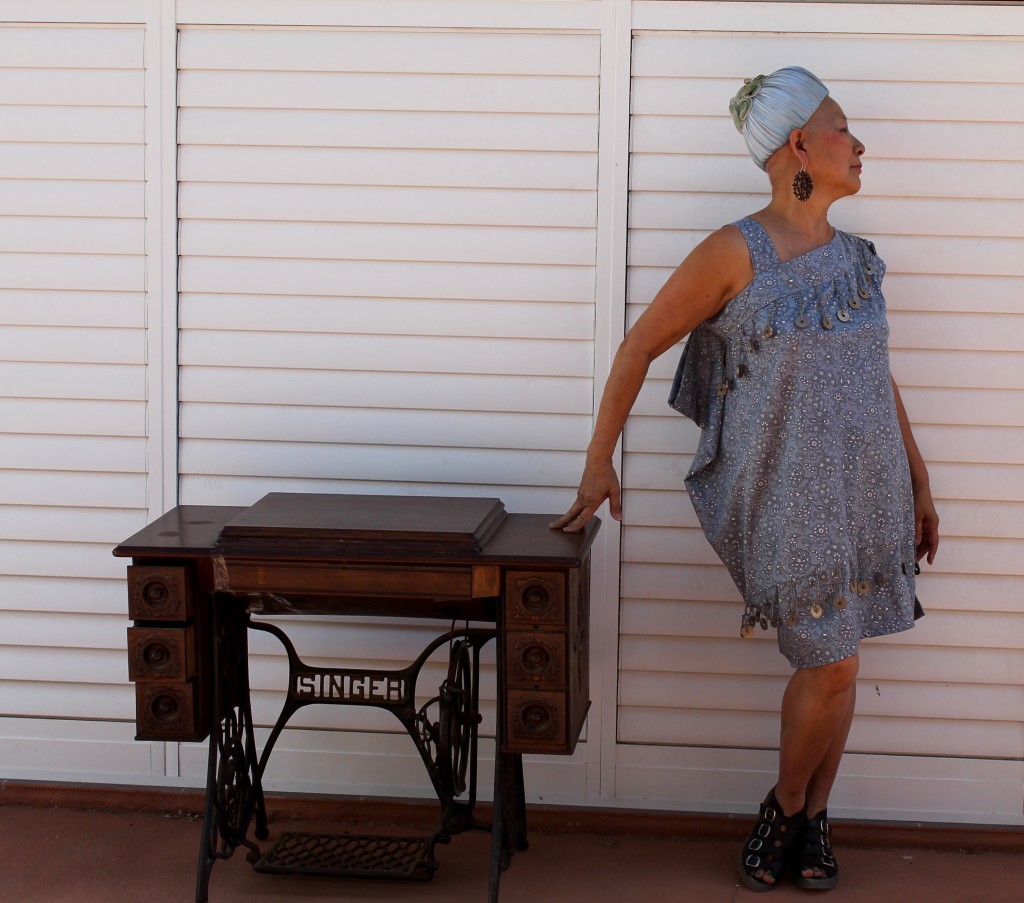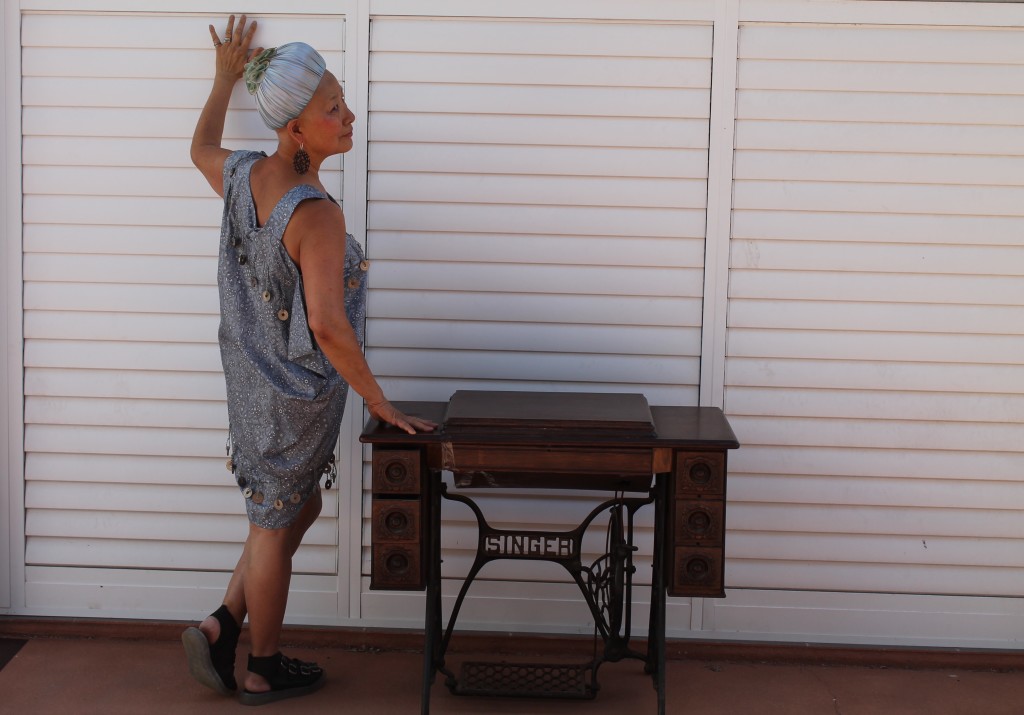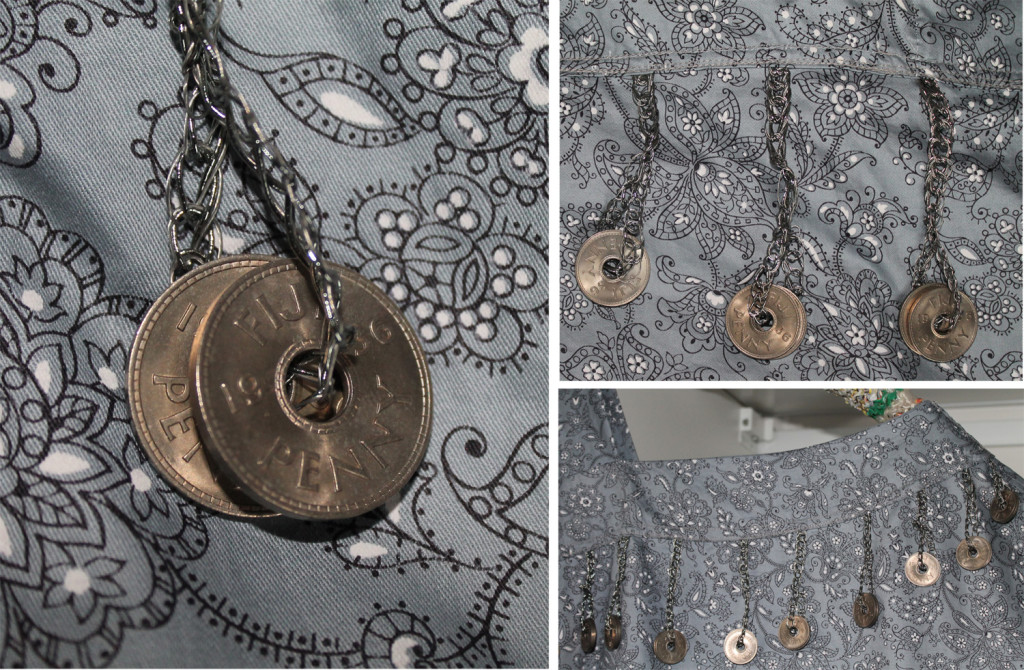Knowing the story behind the garment is a certainty when you’ve made it yourself, and when you’ve been creative and resourceful in the making then you are wearing something totally unique. Such was the case when a friend gave Vivienne Poon some 1936 Fiji pennies and she set about developing a design to incorporated them – in a bodice featuring two-coin tassels which chink when she walks, and a hemline with one-coin tassels that are not too weighty.
Vivienne enjoys making new from old, the challenge of using remnants and found bits of materials, and the opportunity to create and recreate in limitless ways. She claims to be a real dunce at sewing when she began learning during school days. “I did not understand that paper patterns were produced in halves and that ‘cut two’ was conceptually a left and a right side!,” Vivienne said.
“Years later, textiles was a compulsory learning area in my undergraduate Art course and I enjoyed learning about tailoring and technical aspects, embroidery and creating items. Furthermore as a teacher in schools, I always insisted on teaching in both Textiles and Art as they were so complementary.”
“Both my grandmothers sewed, and I still have the family treadle machine. My mother, who lived through WW II on ration cards, taught me to unpick hand-knitted garments to reknit, and salvage all dress fabrics which were made into polishing cloths and floor cloths. I still have Mum’s 1940s skirts, which, when not usable any more, Mum converted into utility bags by securing at the hem.
“I have always been interested in following the Australian fashion/designer scene and love to frequent designers’ workshops sales to purchase the most interesting remnants at the cheapest prices. After sewing for two sons, which was fun but limited, I had unlimited years of sewing for my twin daughters. This was so exciting, creating ‘same but different’ clothing in mix and match colours, from casual to ‘good’ clothes, plus creating a huge wardrobe of dress-up clothing for them from pre-school age to adulthood.
Vivienne became involved in The Slow Clothing Project as a way to influence positive change. She believes that “making” will be the new “doing”.
“I want to spark or reignite interest amongst family and friends to re-create beauty and personal items especially from old fabrics and to encourage others to be creators. Last year I was a finalist in a design competition in New Zealand. It was all about reviving and recycling from old materials to create a contemporary garment. The concept of using old materials and remaking them into a new garment was conceptually the same as The Slow Clothing project, but a little more complicated as it had a design brief attached. I found this a challenging concept and enjoyed the experience,” she said.
“About 30 per cent of my wardrobe is manufactured, bought mainly from manufacturer’s workshop sales. The remainder is from op shops (a passionate pastime), or hand made. I rarely buy from mainstream stores & in the search for interesting fabrics I mainly source remnants from manufacturers’ workshop sales.
“My latest trend is to create an entire outfit after purchasing one element (at discounted prices of course), and use this piece as a starting point for my own story. This provides me with a good springboard for ideas, and allows me scope to divert and create.
“The process to make this garment for The Slow Clothing Project Process was slow! I researched designers and played with design lines and colours in search for inspiration. Then some structure appeared when a friend (who was born and had grown up in Fiji) gave me her collection of treasured Fijian coins. So there were now two bits of history to fit into this project … my friend’s coins and selected yardage from my Apore’s stash (Apore is the Cantonese title for maternal grandmother). This recycling project would provide an interface into the history of two family’s heritage and an incorporation of two cultures. I was fortunate to find a vintage hat (originally made by the mother of an artist colleague), which transforms the outfit from ordinary to extra-ordinary!”
“Research was required to work out how to incorporate the coins from a designer’s viewpoint and the method of attaching the coins. In my research, I found that coins needed to dangle from their own string; an insertion into a seam was the obvious place. But I didn’t want coins dangling at a hem edge or looking like a Bollywood outfit. I adapted a contemporary pattern, instead of purchasing a new pattern – which is all part of the slow clothing ideal.
“The polished cotton fabric I used was originally bought from Buckley & Nunn (a then department store in Melbourne), chosen for its versatility and neutral colour scheme to provide as backdrop for the silver-coloured coins. Craft wire and acrylic yarn that I had been using for knitted and crocheted body pieces and small sculptures were selected as the medium to attach coin to tunic. Making samples and experimenting with technical crochet aspects were now necessary to find the best practice for coins to neatly dangle. Constructing the garment with coins attached was a trial. Coins are not lightweight tassels … .they’re noisy, clumsy and weighty, and drag the fabric this way and that.”
Vivienne said that within her lifetime, fast fashion has deteriorated in quality. “Garments are not necessarily well made despite advances in the versatility of the sewing machine, overlocker etc. The consumer today is not necessarily a selective consumer. The amount of clothing sent to op shops, so much so that op shops find it difficult to move such stock, reflects the supply, demand and cheap cost of today’s clothing. As teenagers, we all wanted quantity rather than quality; that’s the nature of being young with a stock size figure. My mother sewed for me; I wasn’t allowed to buy. And when I was not happy to continue wearing mum’s Enid Gilchrist drafted patterns, I began to make my own gear. Youngsters by and large do not sew for themselves and would purchase. “
For those who missed out learning to sew when they were growing up, what is Vivienne’s advice? “Practise whatever has been learned, Do not just make one item, make more and repeat the learning so that the learning becomes second nature. But whatever you choose to learn/make, you must like it and want to do more.”
Love everything about this Vivienne – thanks for your fabulous contribution 🙂


